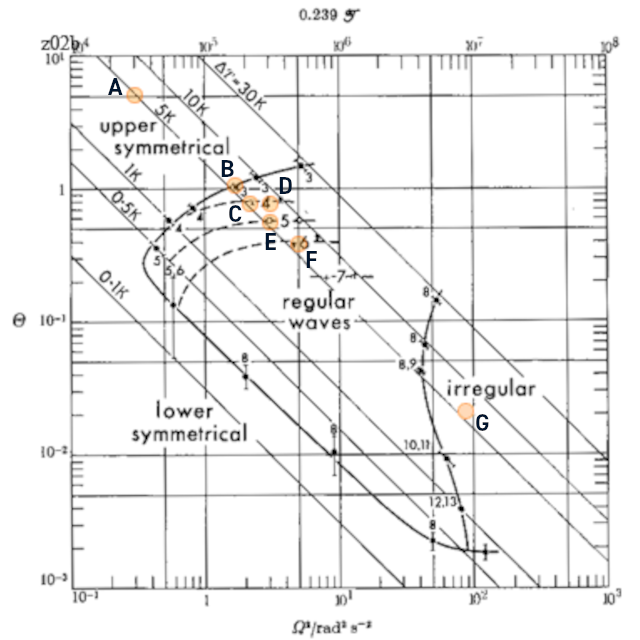Tutorial 1.1
Basic flow regimes in the differentially heated rotating annulus
Sloping convection exhibits a wide range of different types of flow regime, depending upon the strength of heating and background rotation rate \(\Omega\). We can map the behaviour of the flow on a regime diagram as illustrated below. In order to be able to compare experiments carried using different sized apparatus and different working fluids, and to generalize results to other systems, we represent the strength of heating and background rotation rate \(\Omega\) in terms of dimensionless parameters. The main parameters usually used are:
- Taylor number – represents the (squared) ratio of Coriolis to viscous forces (\(\nu\) is the kinematic viscosity): \[\mathrm{Ta}=\frac{4\Omega^2(b-a)^5}{\nu^2d}\]
- Thermal Rossby number or Hide number – represents the ratio of buoyancy to Coriolis forces: \[\Theta=\frac{g(\Delta\rho/\rho)d}{(b-a)^2\Omega^2}\]
- Prandtl number – characterises the working fluid (\(\kappa\) is the thermal diffusivity): \[\sigma=\frac{\nu}{\kappa}\]
Regime diagram
A regime diagram maps the regions of parameter space over which different types of flow are found. Here is an example:

The following video clips provide visualisations of flows at the points labelled A to G on the regime diagram above:
https://youtu.be/97ErUzPXs_8 https://youtu.be/VpJ2B32uNeM
https://youtu.be/GG6rxytEsYw https://youtu.be/zILjL0k8LFU https://youtu…
https://youtu.be/J32rR6drWnY https://youtu.be/OuuRCbyaCnM
Remarks:
- Axisymmetric flow occurs at low values of \(\Omega\) for a given temperature contrast.
- Regular, coherent waves occur at moderate values of \(\Omega\), with a tendency for higher azimuthal wavenumbers at larger \(\Omega\) and Taylor number.
- Within each regular wavenumber regime there may be transitions or bifurcations from steady-wave states to time-dependent states (periodic or chaotic), known as vacillations.
- Irregular, more chaotic flows occur at high \(\Omega\) and large Taylor number / small Hide number \(\Theta\).
Further visualisations
Some other, very impressive, flow visualisations of some of the main regimes in the thermally driven rotating annulus at the top surface (using kalliroscope rheoscopic fluid) were obtained by Richard Pfeffer, George Buzyna, and Robin Kung of Florida State University in Tallahassee (USA) in the early 1980s:
https://youtu.be/VadwVCtgVRA https://youtu.be/5K_-9UO4Sw8
https://youtu.be/xkubwHzO53E https://youtu.be/Yop1gHIUDk0
https://youtu.be/UGYKqDoRBSs https://youtu.be/pBpQEPjNlkU
https://youtu.be/Q20j-3hlygA https://youtu.be/rsBE9F3fhP0
Note that these experiments were carried out with a free upper surface, using silicone oil as working fluid. The temperature was kept fixed and rotation rate gradually increased. As the rotation rate increases, the free upper surface becomes increasingly inclined because of the centrifugal distortion. This introduces a beta-effect, much as found when the horizontal boundaries are deliberately sloped.
